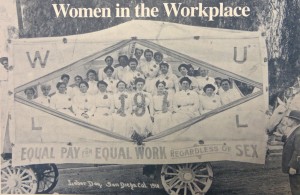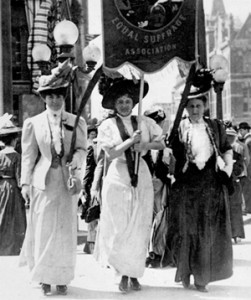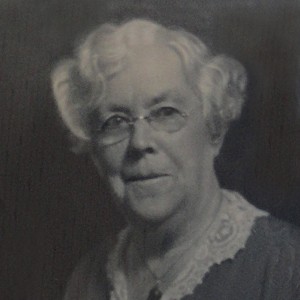Women’s suffrage, the fight for right
When writing the United States Constitution our founding fathers forgot about their mothers, aunts and daughters. It took 144 years (from 1776 to 1920) before these women were allowed the same right as their brothers. “Failure is impossible,” stated Susan B. Anthony. But she forgot to mention how slow success could be. This tireless activist worked every waking hour for 50 years so women could vote. Sadly, she died 14 years before her goal was realized thanks to selfless leaders like Alice Paul.
The demand for extending the ballot to women began in earnest after the Civil War. Black men could vote, why not women? The Wyoming territory was first to allow women the right to vote (1869) followed by Colorado (1893), Utah & Idaho (1896) and Washington (1910).
Early California success came in 1893 when a women’s suffrage bill won approval in the state level, but the governor thought it was unconstitutional and vetoed it. In 1896, women took the issue directly to the voters for a statewide referendum and were soundly defeated. Suffragists blamed opposition from the liquor industry (which feared women would support prohibition), corporations and the Republican Party.
Another campaign was triggered in January 1911 when the new Progressive legislature placed the amendment on the October ballot. Women throughout the state organized, conducting a tactical and spirited campaign to enfranchise female residents. Guided by national suffrage organizations and the Women’s Christian Temperance Union, Dr. Charlotte Baker (the first female physician in San Diego) led the local charge. The San Diego Sun reported, “50 years ago there was not one woman’s club in existence. Today there are more than 8,000 of them.” Women saw that suffrage (the right to vote) would help effect needed changes. Dr. Charlotte was acutely aware of women’s struggles, and the well-respected civic leader directed an intense nine-month effort.
 Dr. Charlotte had been participating in the San Diego Equal Suffrage Association since 1906, attending monthly meetings and making speeches. After her election to president, the group went full throttle to educate the public by using billboards, electric signs, high-school essay contests, pageants, plays, parades, street meetings, picnics, parlor talks and rainbow-colored fliers. Dr. Charlotte and Ella Allen worked closely writing speeches and plotting strategies. What may have turned the tide were their auto tours campaigning along the county’s back roads with stops in Escondido, Ramona, Palomar, Temecula and Santa Ysabel. This was the first time women had spoken up in public parks or from the roadside.
Dr. Charlotte had been participating in the San Diego Equal Suffrage Association since 1906, attending monthly meetings and making speeches. After her election to president, the group went full throttle to educate the public by using billboards, electric signs, high-school essay contests, pageants, plays, parades, street meetings, picnics, parlor talks and rainbow-colored fliers. Dr. Charlotte and Ella Allen worked closely writing speeches and plotting strategies. What may have turned the tide were their auto tours campaigning along the county’s back roads with stops in Escondido, Ramona, Palomar, Temecula and Santa Ysabel. This was the first time women had spoken up in public parks or from the roadside.
On Election Day women and their supporters throughout the state continued to campaign mostly in the outlying districts. (Many city men didn’t want their quality of life changed by voting women.) Throughout the night, Dr. Charlotte tallied results on an immense blackboard listing the state’s cities and towns. With one-third of the vote counted, the results were bleak — 44,659 against and 37,170 in favor. (It even failed in her  precinct.) But the leader didn’t give up hope, always feeling that the greatest support would come from the rural areas where the results would take longer to report. Her instinct was correct. Ultimately, the amendment passed by a 17% margin in the city and by 41% in San Diego County.
precinct.) But the leader didn’t give up hope, always feeling that the greatest support would come from the rural areas where the results would take longer to report. Her instinct was correct. Ultimately, the amendment passed by a 17% margin in the city and by 41% in San Diego County.
But there was little time for victory celebrations as Dr. Charlotte’s team immediately hit the streets to attend meetings and sign up women voters. Within a week 2,528 were registered, and weekly gatherings were organized to hear arguments for and against a harbor improvement bond measure put forward by city engineer Edwin Capps who believed that the opening of the Panama Canal would provide opportunities for new trade. Capps, fearful that the women’s vote might be nullified, put forth a contingency that ballots cast by women be marked for later identification if needed. On November 15 San Diego voters (both men and women) approved the initiative with a tally 7,196 to 183.
It took nearly another decade for all American women to vote.
Every year on August 26 we honor those who fought in the struggle for a woman’s right to vote. (If you’ve not seen the movie Iron-jawed Angels, rent it!) Please don’t take their struggle for granted. Vote! Even though a century later research shows that females make better leaders, women’s equality still is not guaranteed by our Constitution.
